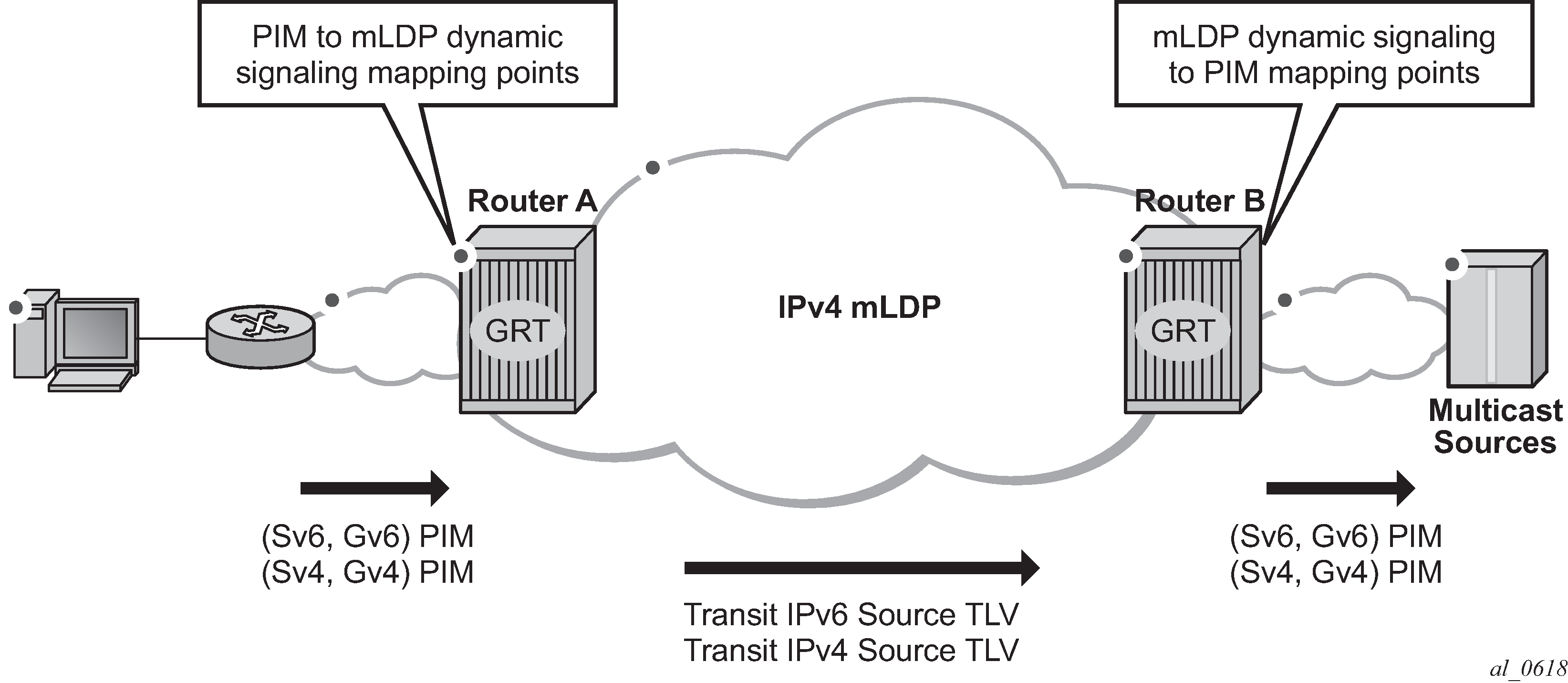This feature provides a flexible multicast signaling solution to connect native IP multicast source and receivers running PIM multicast protocol via an intermediate MPLS (P2MP LDP LSP) network. The feature allows each native IP multicast flow to be connected via an intermediate P2MP LSP by dynamically mapping each PIM multicast flow to a P2MP LDP LSP.
The feature uses procedures defined in RFC 6826: Multipoint LDP In-Band Signaling for Point-to-Multipoint and Multipoint-to-Multipoint Label Switched Paths. On the leaf node of a P2MP LSP, PIM signaling is dynamically mapped to P2MP LDP tree setup. On the root node of P2MP LSP, P2MP LDP signaling is handed back to PIM. Because of dynamic mapping of multicast IP flow to P2MP LSP, provisioning and maintenance overhead is eliminated as multicast distribution services are added and removed from the network. Per (S,G) IP multicast state is also removed from the network where P2MP LSPs are used to transport multicast flows.
Figure: Dynamic MLDP signaling for IP multicast in GRT illustrates dynamic MLDP signaling for IP multicast in GRT.

As illustrated in Figure: Dynamic MLDP signaling for IP multicast in GRT, P2MP LDP LSP signaling is initiated from the router that receives PIM JOIN from a downstream router (Router A). To enable dynamic multicast signaling, p2mp-ldp-tree-join must be configured on PIM outgoing interface of Router A. This enables handover of multicast tree signaling from PIM to P2MP LDP LSP. Being a leaf node of P2MP LDP LSP, Router A selects the upstream-hop as the root node of P2MP LDP FEC based on routing table lookup. If an ECMP path is available for a specific route, then the number of trees are equally balanced toward multiple root nodes. The PIM Joins are carried in Transit IPv4 (IPv4 PIM-SSM) or IPv6 (IPv6 PIM-SSM) MLDP TLVs. On the root node of P2MP LDP LSP (Router B), multicast tree signaling is handed back to PIM and propagated upstream as native-IP PIM JOIN.
The feature is supported with IPv4 and IPv6 PIM-SSM and IPv4 MLDP. Directly connected IGMP/MLD receivers are also supported with PIM enabled on outgoing interfaces and SSM mapping configured if required.
If multiple criteria exist to setup a multicast flow, the following priority is given as follows:
Multicast (statically provisioned) over P2MP LSP (RSVP-TE or LDP)
Dynamic multicast signaling over P2MP LDP
PIM native-IP multicast
The following are feature restrictions:
A single instance of P2MP LDP LSP is supported between the root and leaf nodes per multicast flow; there is no stitching of dynamic trees.
Extranet functionality is not supported.
The router LSA link ID or the advertising router ID must be a routable IPv4 address (including IPv6 into IPv4 MLDP use cases).
IPv6 PIM with dynamic IPv4 MLDP signaling is not supported with e-BGP or i-BGP with IPv6 next-hop.
Inter-AS and IGP inter-area scenarios where the originating router is altered at the ASBR and ABR respectively, (therefore PIM has no way to create the LDP LSP toward the source), are not supported.